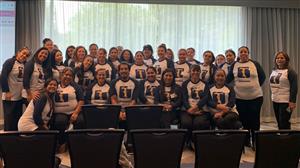Mesquite
To inspire every student to do more, expect more, and be more.
- Mesquite Campus
- Homepage
Mesquite Campus Pilots On-Site Meal Preparation
Many schools the size of TBP, as well as many school districts, rely on outside vendors to ensure that no student goes without a hot breakfast or lunch each school day. But this year, TBP is piloting on-site food preparation at its Mesquite campus with plans toward replicating this model district-wide over the coming years.
“Mesquite was easiest choice because it’s one of the newest campuses and we planned to have a full kitchen,” Child Nutrition Coordinator Juan Lopez said. “With food service based on an outside provider, when constructing the Mesquite campus, we saw the ability to build the campus to pilot this program.”
Healthier and fresher ingredients are possible through removing third party vendors and a two-stage heating cycle.
“We use a lot fresher fruit on the meals prepared at Mesquite,” Lopez said. “We have more control over quality and can get fresher foods to student when we control that rather than using an outside vendor.”
For district leadership, the Mesquite pilot is an extension of TBP’s overall mission.
“This program is a positive development in our path towards doing more for students,” Chief Development Officer Brandon Duck said. “Juan Lopez is looking for feedback as he continually improves the content and quality of the meals he is creating for Mesquite as that will be the basis for all other campuses in the future.”
TBP’s current plans, pandemic permitting, are to expand the onsite food preparation program to Panola in January 2022 and Pafford in August 2022.
“They have the equipment already,” Lopez said. “We are excited to try to present a new product to the students of Fort Worth. We have low lunch participation in that area and are hoping with a new menu and our own creation, students and staff alike will eat more on campus. We hope to do this in Dallas eventually, but there is a limitation in Dallas due the facilities.”

Adhering to TEA and USDA guidelines for micronutrients, TBP’s child nutrition team works those considerations into a week’s worth of menu options.
“Liliana Munoz curates the menu and we try to give it our own flair,” Lopez said. “We know what kids like, so we take the popular items and divvy them up throughout the month to balance them with other options. Everything is whole grain, most things are reduced fat, but for the most part the menu is ‘our baby’ and we continue to use student input to gauge what the menu should be. We are always looking to add fun items or improve on areas where students are not fans of the menu. We are trying to add a bit of culture in it with authentic as can be enchiladas, tacos, and other traditional foods.”
While nutrition is at the forefront of TBP’s pilot program, taste is also a key concern.
“ISD’s cook everything in house and they cook in bulk to reduce costs,” Lopez said. “They gain a reputation for bland food and the quality suffers. With so many families struggling with food insecurity at home and TBP providing students two meals a day, we want them to like it. We want them to be excited to pass through our lunch lines.”
Quality, not price, is the primary driver of the new model.
“I don’t mind paying a bit more for better quality food,” Lopez said. “Money paid into the program goes right back into the program. It can always be used for better quality food.”
For his part, Lopez has always been involved with food, having worked at Panera Bread early in his career through his bachelor’s degree from UNT to his role in Child Nutrition at TBP.
“School food has a negative rap,” Lopez said. “I check in with students when I’m on campus to I ask kids ‘Did you like the food? What did you want to see?’ From a nutrition and appeal to kids’ perspective, it makes sense.”

Despite the focus on the menu options, the implementation of this pilot program is truly a team effort.
“At the end of the day, the food service staff are putting in the work every day,” Lopez said. “We are there training them working with them to get this up and running, but we are giving them the responsibility to give students the best product possible. It is the food managers and staff that really make this program work.”

